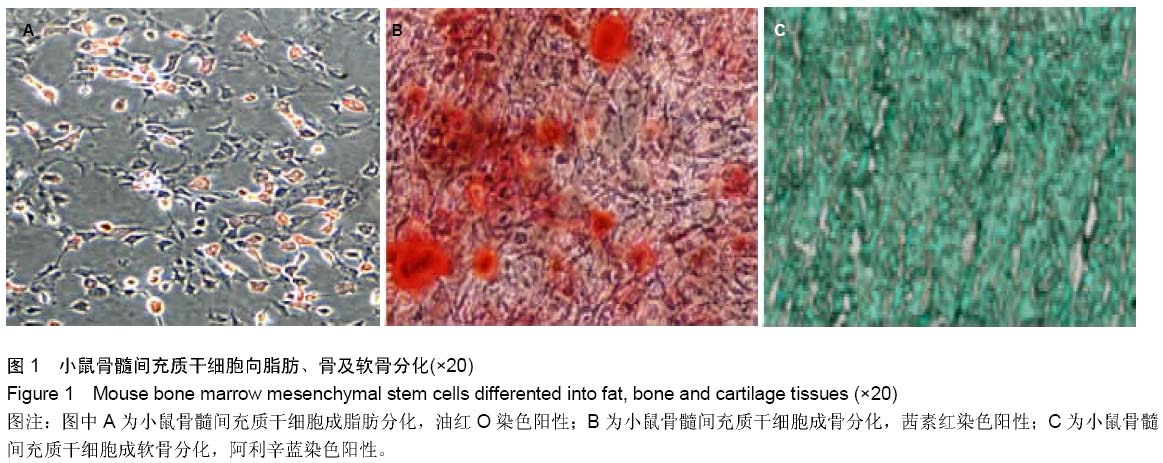
2.1 小鼠骨髓间充质干细胞形态 48 h内贴壁的细胞起初形态不甚均一、异质性大,有成纤维样细胞,也有小的圆形细胞等。大约4 d时,这些细胞开始增生,逐渐形成小的细胞集落。7 d时,不同大小的细胞集落明显增大,集落中的细胞生长浓密,呈梭形或多角形。细胞数量逐渐增加,体积增大,排列开始出现方向性,呈漩涡样生长。15 d左右间充质干细胞扩增至10
7数量级。随着细胞的不断生长,细胞集落直径不断增加和邻近细胞互相连接,细胞形态比较均一。20 d左右细胞融合80%-90%,呈漩涡状。
传代培养的干细胞生长方式和原代细胞相似。细胞呈圆形,接种4 h开始贴壁,逐渐恢复为长梭形。24 h完全贴壁,形态与原代细胞相似,但增殖速度明显增快,不再以集落的方式生长,而是呈均匀分布的纺锤形细胞平均生长,5 d即可传代1次,且细胞形态单一均匀,融合后呈典型的极性,漩涡状生长。传代后间充质干细胞呈均匀分布生长,小而圆的细胞随着传代而逐渐减少。细胞形态开始呈比较均一的成纤维状。第7代小鼠骨髓间充质干细胞形态单一均匀, 融合后呈典型的极性。细胞形态呈比较均一的成纤维状,连续传代,细胞形态无明显变化,说明骨髓间充质干细胞得到了进一步的纯化。部分贴壁细胞传代达20次以上,细胞并无衰老迹象。
2.2 小鼠骨髓间充质干细胞向脂肪、骨及软骨分化 骨髓间充质干细胞汇合度约达90%时,加入成脂诱导液,培养22 d后进行油红O染色,可见红色脂滴,成脂阳性率约30%(
图1A);骨髓间充质干细胞汇合度约达70%时,加入成骨诱导液,培养22 d后进行茜素红染色,成骨诱导阳性率约达50%(
图1B);骨髓间充质干细胞汇合度约达70%时,加入成软骨诱导液,培养22 d后进行阿利辛蓝染色,成骨诱导阳性率约达80%(
图1C)。
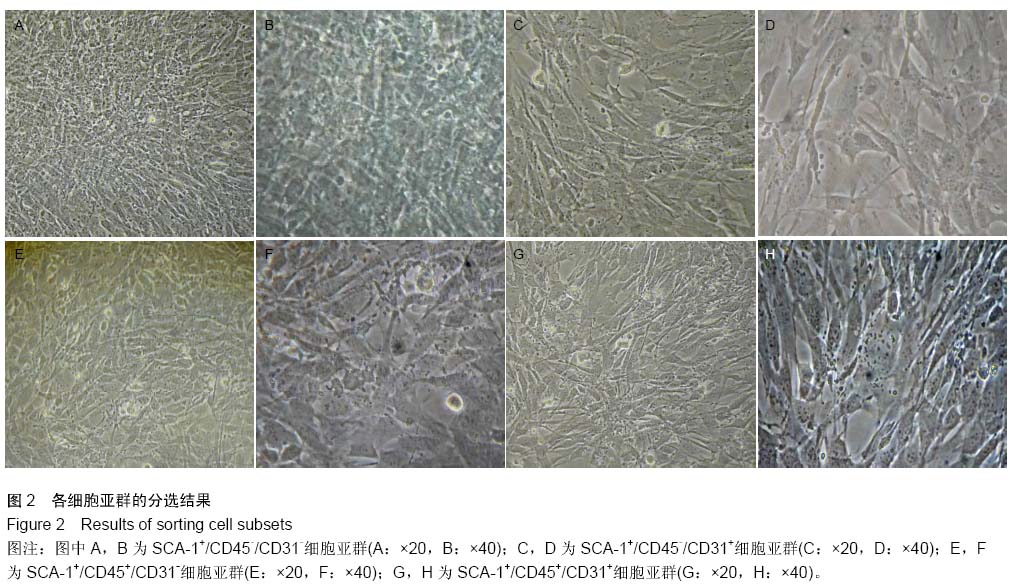
2.3 小鼠骨髓间充质干细胞流式鉴定结果 小鼠骨髓间充质干细胞CD29(细胞整合素分子)表达率为99.71%、SCA-1(干细胞抗原1)表达率为97.74%、CD44(黏附分子) 表达率为97.28%,不表达造血祖细胞表面标志CD11b (0.34%)。
2.4 各细胞亚群的分选结果 见
图2。
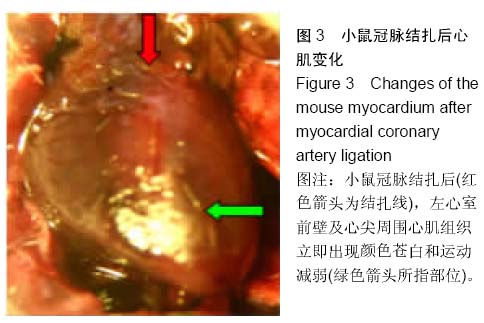
2.5 心肌梗死模型小鼠一般情况 直视下完成小鼠心肌梗死造模,冠脉结扎术后小鼠精神萎靡呈蜷缩状、活动较少、呼吸浅促、抓起时反抗较轻,毛发枯槁呈黄白色、多见倒竖,进食量明显减少,左前降支冠脉结扎成功标志为左心室前壁及心尖周围心肌组织立即出现颜色苍白和运动减弱(
图3)。心肌梗死后48 h超声心动图检测,可见左室前壁已明显变薄,左室射血分数下降(
图4)。

2.5 心肌梗死模型小鼠一般情况 直视下完成小鼠心肌梗死造模,冠脉结扎术后小鼠精神萎靡呈蜷缩状、活动较少、呼吸浅促、抓起时反抗较轻,毛发枯槁呈黄白色、多见倒竖,进食量明显减少,左前降支冠脉结扎成功标志为左心室前壁及心尖周围心肌组织立即出现颜色苍白和运动减弱(
图3)。心肌梗死后48 h超声心动图检测,可见左室前壁已明显变薄,左室射血分数下降(
图4)。

2.6 体外实验检测各组亚群细胞的归巢能力 采用Transwell小室检测SCA-1
+/CD45
+/CD31
-、SCA-1
+/CD45
-/ CD31
-、SCA-1
+/CD45
+/CD31
+、SCA-1
+/CD45
-/CD31
+、未分选组细胞的归巢能力(
图5-7)。每个亚群细胞及未分选群取3个高倍镜视野,镜下细胞计数,每组细胞重复3次,见
表1。
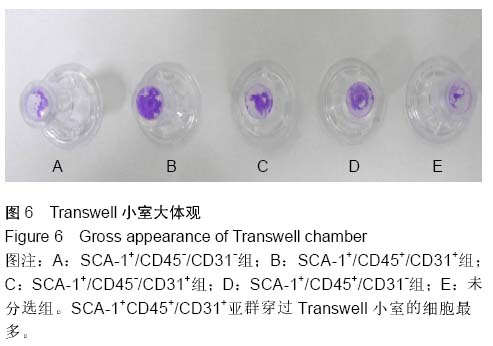
2.6 体外实验检测各组亚群细胞的归巢能力 采用Transwell小室检测SCA-1
+/CD45
+/CD31
-、SCA-1
+/CD45
-/ CD31
-、SCA-1
+/CD45
+/CD31
+、SCA-1
+/CD45
-/CD31
+、未分选组细胞的归巢能力(
图5-7)。每个亚群细胞及未分选群取3个高倍镜视野,镜下细胞计数,每组细胞重复3次,见
表1。
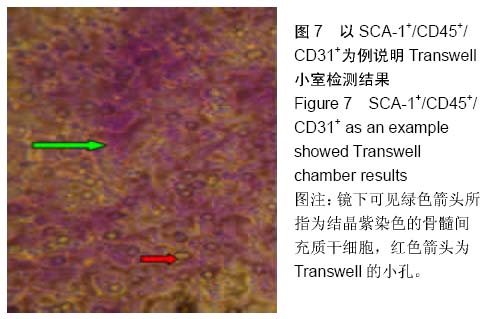
2.6 体外实验检测各组亚群细胞的归巢能力 采用Transwell小室检测SCA-1
+/CD45
+/CD31
-、SCA-1
+/CD45
-/ CD31
-、SCA-1
+/CD45
+/CD31
+、SCA-1
+/CD45
-/CD31
+、未分选组细胞的归巢能力(
图5-7)。每个亚群细胞及未分选群取3个高倍镜视野,镜下细胞计数,每组细胞重复3次,见
表1。
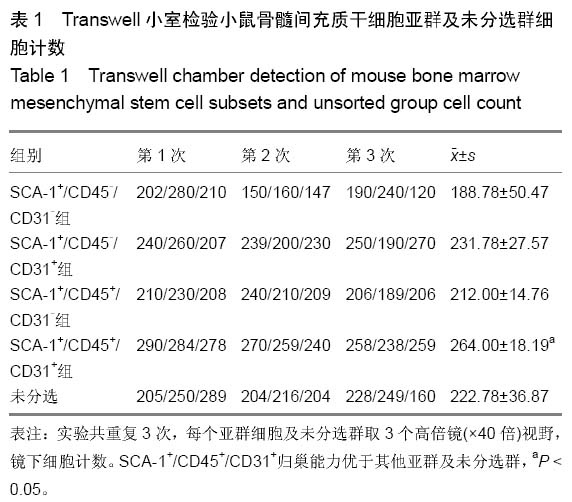
2.6 体外实验检测各组亚群细胞的归巢能力 采用Transwell小室检测SCA-1
+/CD45
+/CD31
-、SCA-1
+/CD45
-/ CD31
-、SCA-1
+/CD45
+/CD31
+、SCA-1
+/CD45
-/CD31
+、未分选组细胞的归巢能力(
图5-7)。每个亚群细胞及未分选群取3个高倍镜视野,镜下细胞计数,每组细胞重复3次,见
表1。
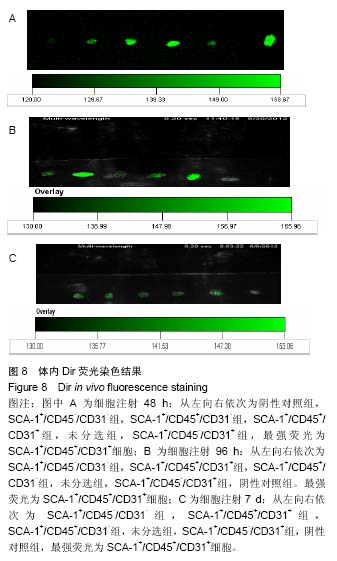
2.7 体内通过小动物活体成像证明SCA-1
+/CD45
+/ CD31
+亚群具有更强的归巢能力 心肌梗死48 h,将SCA-1
+/CD45
-/CD31
-,SCA-1
+/CD45
-/CD31
+,SCA-1
+/ CD45
+/CD31
-,SCA-1
+/CD45
+/CD31
+及未分选群细胞采用Dir荧光染色经小鼠尾静脉注入小鼠体内,于48,96 h,7 d后处死小鼠取心脏行小动物活体成像检测其荧光强度(
图8A-C)。SCA-1
+/CD45
+/CD31
+归巢能力优于其他亚群及未分选群(
图9)。
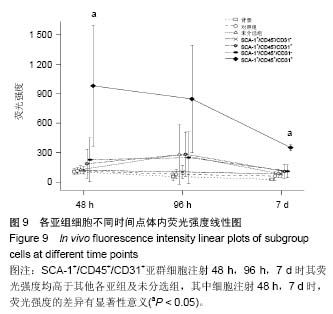
2.7 体内通过小动物活体成像证明SCA-1
+/CD45
+/ CD31
+亚群具有更强的归巢能力 心肌梗死48 h,将SCA-1
+/CD45
-/CD31
-,SCA-1
+/CD45
-/CD31
+,SCA-1
+/ CD45
+/CD31
-,SCA-1
+/CD45
+/CD31
+及未分选群细胞采用Dir荧光染色经小鼠尾静脉注入小鼠体内,于48,96 h,7 d后处死小鼠取心脏行小动物活体成像检测其荧光强度(
图8A-C)。SCA-1
+/CD45
+/CD31
+归巢能力优于其他亚群及未分选群(
图9)。









